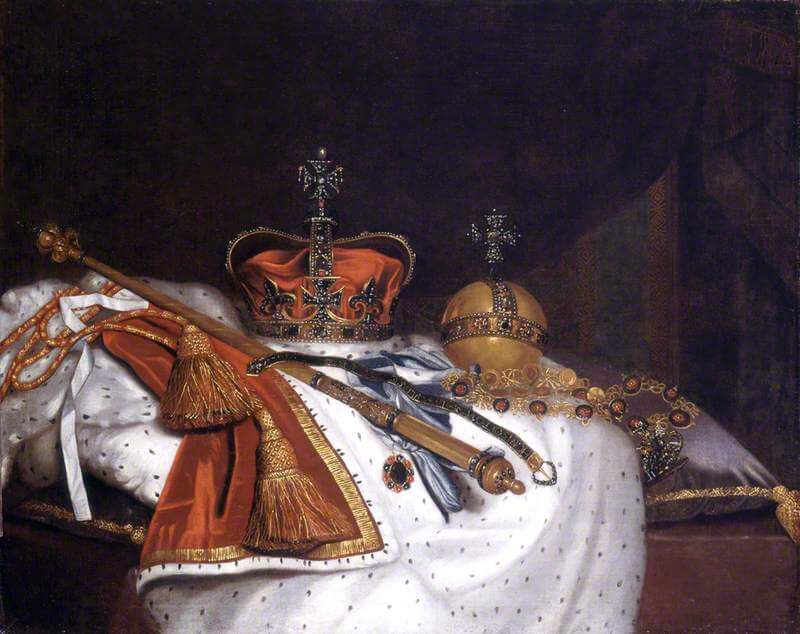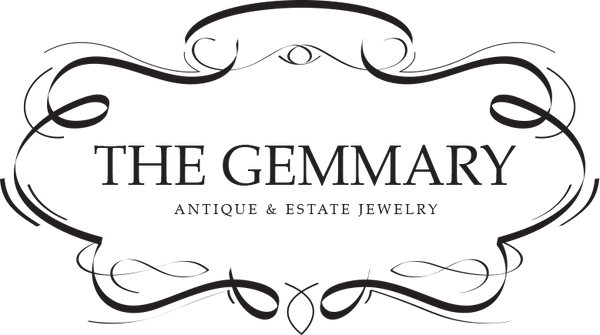
England’s Crown Jewels: Emblems of A Monarchy
by Dani Chavez
The royal family of Great Britain is continuously in the news for babies, birthdays, and philanthropy. With the Queen's 95th birthday last week and the birth of Prince Harry's son, I've decided to focus this entry on the remarkable Crown Jewels of the United Kingdom. The most well-known of the royal jewelry troves, these 140 outstanding jewelry pieces hold centuries of stories and secrets and are culturally significant in British history. Even these gemstones tell a tale, from the Black Prince's Ruby to the infamous Koh-i-Noor diamond.

The Tower of London
I'll never forget climbing the dangerous spiral stone staircase of the Tower of London and catching my first glimpse of The Jewel House. I visited around the year 2000, and at that time, the gemstones were displayed in a large glass case next to the torture exhibit. The lighting perfectly enhanced the gemstones, and the sparkle was almost blinding! I believe it was at this moment that my love of antique jewelry came to be.
 Coronation of Queen Victoria in Westminster Abbey, 28 June 1838, by Sir George Hayter. Image: Wikipedia
Coronation of Queen Victoria in Westminster Abbey, 28 June 1838, by Sir George Hayter. Image: Wikipedia
A BRIEF HISTORY
The Crown Jewels, also known as the Coronation Regalia, are used during the coronation of any sovereign. The ceremony dates back to the 8th century and has been performed at Westminster Abbey for 900 years.
 Portrait of Charles II in the Royal Regalia by John Michael Wright, 1661. Image: Public domain, via Wikimedia Commons
Portrait of Charles II in the Royal Regalia by John Michael Wright, 1661. Image: Public domain, via Wikimedia Commons
Most of the collection dates back to around 1660, when Charles II ascended the throne and restored the monarchy. Prior Crown Jewels were destroyed by Cromwell's Parliamentary Commissioners, who believed they represented everything detestable about the rule of kings. Luckily, drawings of the earlier pieces survived these tumultuous times, and the jewels we see today are modeled after these sketches.
Over the years, jeweler Sir Robert Viner added pieces to the original collection. Until the 20th century, the significant gemstones were rented for coronations at 4% of their value and then returned to the jewel houses. Simultaneously, glass or paste imitation jewels were set into the jewelry and placed back on display for the public.
The collection features many processional objects, including maces, swords, trumpets, and coronation robes. I will focus on the jewelry and gilded objets d'art for this article.
THE JEWELS

St. Edward's Staff (left). Image: Man vyi, Public domain, via Wikimedia Commons
St. Edward's Staff, crafted in 1661, is an anomaly in the collection because its meaning and original purpose in the ceremony are unknown. After the procession, it is laid on the altar in Westminster Abbey and has no further role. The staff is shrouded in mystery, and even a Tower of London guidebook from 1831 claims that a piece of the "true cross" is enclosed in the top monument.

The Ampulla and Coronation Spoon (top right). Image: Francis Sandford (1630 – 1694), Public domain, via Wikimedia Commons
The Ampulla and Coronation Spoon are also part of Charles II's coronation in 1661. It contains the holy oil, which anoints the Sovereign's head after they move to St. Edward's Chair – the coronation chair – from the Chair of State. The eagle-shaped ampulla was created in 1661. The head screws off to fill the vessel, and a small hole in the beak allows for the oil to be poured. However, the spoon is the oldest piece of the collection and the only survivor of the original 12th-century collection.
The Sovereign's Orb and the Regalia of Charles II. Image: London Museum, Public domain, via Wikimedia Commons
The Sovereign's Orb (1661) and Queen Mary II's Orb (1689) are placed into the Sovereign's right hand to symbolize their role as the head of the Anglican church and Christian sovereignty over the planet. In 1671, the Sovereign's orb was damaged during an attempted heist by Colonel Thomas Blood. Queen Mary's orb was only used once during William and Mary's coronation, as Mary was a queen in her own right. Mary's orb was set with borrowed jewels and currently displays glass paste stones, while the Sovereign's orb is set with over 600 gemstones, including 12 large diamonds, 30 rubies, sapphires, and emeralds.

 The Sovereign and Queen's Consort Rings. Image: Public domain, via Wikimedia Commons
The Sovereign and Queen's Consort Rings. Image: Public domain, via Wikimedia Commons
The coronation rings are exquisite and typically placed upon the Sovereign's right hand's fourth finger. The Sovereign's ring on the top is also called the 'ensign of kingly dignity' and was made alongside the Queen's Consort Coronation ring (bottom) in 1831 for Queen Adelaide and King William IV. Before this, each coronation had a special ring crafted for the occasion, which stayed in the Sovereign's possession for the duration of their reign. The Sovereign's Ring has been used in every coronation since Edward VII's to Queen Elizabeth II's. Queen Alexandra, Queen Mary, and Elizabeth the Queen Mother wear the smaller Queen's Consort ring.
 The Sovereign's Sceptre with Cross. Image: United Kingdom Government, Public domain, via Wikimedia Commons
The Sovereign's Sceptre with Cross. Image: United Kingdom Government, Public domain, via Wikimedia Commons
The Sovereign's Sceptre with Cross was also created for the coronation of Charles II in 1661. The scepter is placed in the right hand and symbolizes control over the kingdom against uprisings. The Sceptre with the Dove is placed in the left hand and represents the gathering and confinement of stray men. In 1907, the largest diamond ever mined, the Cullinan, was presented to King Edward VII by the Government of the Transvaal to mend tensions following the Boer War between Great Britain and South Africa. The stone was cut into 106 diamonds, including nine large stones of great significance, each labeled 1 through 9. The Cullinan I, also known as the Star of Africa, was transformed into the Sovereign's Sceptre in 1910 for George V's coronation and is the most significant, top-quality cut white diamond in the world, weighing in at a whopping 530.2 carats.
 The Cullinan Diamonds. Image: Wikipedia
The Cullinan Diamonds. Image: Wikipedia
Probably the most well-known and sacred of all the crowns in the collection, St. Edward's Crown is made of solid gold and is extremely heavy, weighing 71 ounces. The crown is permanently set with 444 semi-precious and precious gemstones. It is the moment when the Sovereign is enthroned, with the Archbishop of Canterbury gently placing the crown upon the Sovereign's head while onlookers erupt into "God save the King/Queen!" The crown was made for Charles II in 1661 and possibly contained melted gold from the medieval crown, which was destroyed in 1649.
The Imperial State Crown. Image: Wikipedia
The Imperial State Crown is relatively new. It now replaces the St. Edward's Crown on the Sovereign's head when they take Holy Communion, change into purple robes, and prepare for the closing procession. This crown is used more commonly than the others. It is worn while the Sovereign exits Westminster Abbey and is adorned for the annual State Opening of Parliament.
 Portrait of Edward the Black Prince by Robby Copeland. Image: Wikimedia
Portrait of Edward the Black Prince by Robby Copeland. Image: Wikimedia
This crown features the Cullinan II, also known as the Second Star of Africa, and is a cushion-cut brilliant weighing 317.4 carats. Directly above this is the Black Prince's Ruby, one of the oldest pieces of the crown jewels — dating back to the mid-14th century, this irregularly cut cabochon weighed 170 carats. The stone was initially owned by the Arab Muslim Prince of Grenada, Abū Sa’īd. After his slaughter by Don Pedro the Cruel in Seville, the Don gifted the stone to the Black Prince to show appreciation for squashing a rebellion led by his brother. The "ruby" was then given to the monarchs of England by Edward of Woodstock in 1367 and has remained part of the British Crown Jewels ever since. In 1937, Queen Victoria's Imperial Crown was remade to reduce weight to its current form, and the Black Prince's Ruby was discovered to be a spinel.
 Koh-i-Noor Diamond.
Koh-i-Noor Diamond.
Next to the Hope Diamond, the Koh-i-Noor is the most infamous diamond ever. Along with the Hope, this diamond is considered cursed and has a long history of death, deceit, and still contested ownership. The origins are shrouded in mystery and tall tales, but we know it came from India's legendary Golconda mining district. Koh-i-Noor is Persian for "Mountain of Light" and is one of the world's largest cut diamonds at 105.6 carats.
The exact history is vague, but this fantastic diamond has been passed down from ruler to ruler in India, Pakistan, Iran, and Afghanistan through war, misadventure, and treason. Most likely mined in the 16th century, the Koh-i-Noor finally came to Queen Victoria's possession in 1849 and was re-cut and set in 1852. It has moved from crown to crown over the years and now adorns the Crown of Queen Elizabeth, the Queen Mother's crown, which was set in 1937. This post has too much history to cover, but one last interesting fact: King George V hid the stone at the bottom of a pond near Windsor Castle during World War II.
 Portrait of Queen Victoria by George Hayter, 1838. Image: Wikimedia
Portrait of Queen Victoria by George Hayter, 1838. Image: Wikimedia
There are many more crowns, scepters, and stones to see, but these pieces are central to the crowning of a new Sovereign and hold fascinating stories. Throughout revolts, coups, and attempted heists, these Crown Jewels have remained a symbol of England's wealth and power for centuries and continue to inspire awe today. I highly recommend visiting London and seeing the Jewel House in the Tower of London.


 The Sovereign and Queen's Consort Rings. Image: Public domain, via Wikimedia Commons
The Sovereign and Queen's Consort Rings. Image: Public domain, via Wikimedia Commons